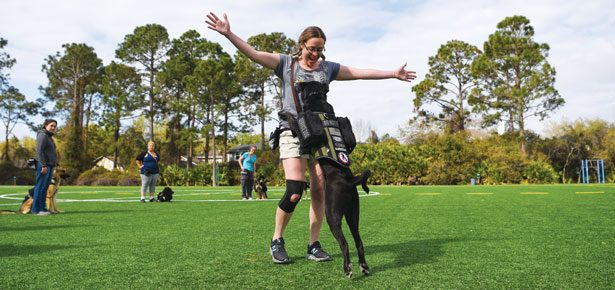
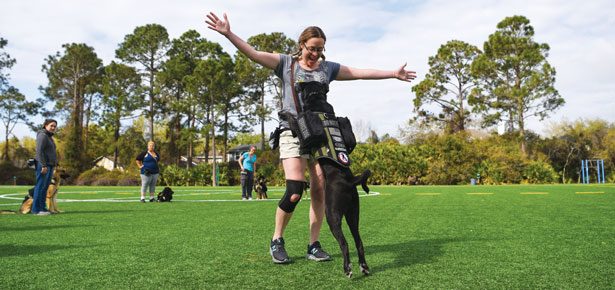
4 Amazing Charities Helping Dogs and People
These four charities are transforming the lives of dogs and the people who love (and need) them.
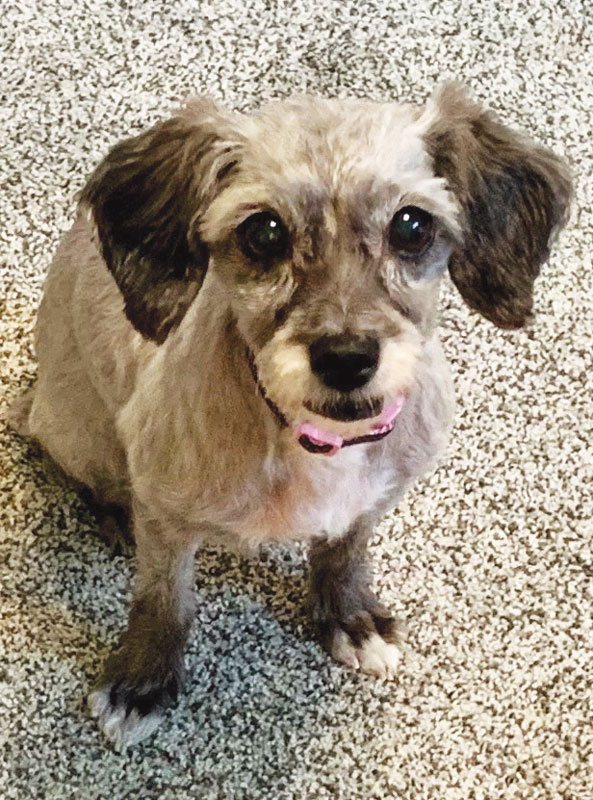
Second chances for senior dogs dumped at shelters
When Kathleen McGovern first met the sick, scared foster dog carried by a volunteer from Chicago’s Second City Canine Rescue, she didn’t think the poor dog would last for long. Susie Q’s fur was overgrown and matted, her bones jutted out, and a partially severed, infected leg dangled from her body. Inert and withdrawn, the recently surrendered Miniature Schnauzer, thought to be 14 years old, seemed resigned to a lifetime of suffering.
Kathleen’s reaction was visceral. “Oh heck, yeah, you’re coming home with me,” she determined.
The small Schnauzer lay low for a few days after her leg amputation. Kathleen and her husband settled her in a warm, private room filled with comfortable blankets. The dog curled up in the smallest, snuggest bed and quietly observed the household from behind the safety of the baby gate.
Three days later, the listless little dog did something unexpected: She howled for a treat. With each passing day the invalid filled out, gained strength, and became more vibrant. Before long she was running wild in the yard on her three remaining legs.
Kathleen was astonished at the dog’s transformation from silent to “spitfire.” “She learned…things were good…and her true personality [emerged],” says the animal advocate. Having nursed Susie Q back to health, the couple couldn’t bear to part with the dog and adopted her last year.
Susie Q owes her rebirth to the non-profit Grey Muzzle, which gave a grant to Second City Canine Rescue, the organization that paired Susie with Kathleen. Grey Muzzle finances animal shelters, rescue organizations, sanctuaries, and other agencies serving at-risk senior dogs, funding their medical needs, dental care, and hospice programs, says the agency’s Executive Director, Lisa Lunghofer. The non-profit also helps innovative initiatives like swimming therapy for arthritic dogs, professional photos showcasing senior dogs in need of a home, and more.
Grey Muzzle fills a huge need. “Old dogs are in a particularly precarious position,” says Lisa. They’re given up by owners who either can’t pay for their health care, or simply don’t value aging animals. Senior dogs also tend to be overlooked by potential adopters looking for puppies.
But there are many benefits to older pets, says Lisa. Since their personalities are fully formed, you know what you’re getting. As well, most have spent their lives in homes and are already housebroken. Older pets with lower energy levels are especially suited to seniors who might be isolated, motivating them to go for walks and spurring chats with passersby.
Kathleen feels blessed to have Susie Q in her life. The Schnauzer is “unstoppable”—she chases anything you throw and tires out the other pets. She’s also the most affectionate dog her owner has ever known. “She’s so plugged in, she interacts almost in a human way.”
The animal Kathleen once thought was doomed has inspired a new outlook. “She has taught us…to always be open to the possibility that something good is going to come,” she says.
Visit the Grey Muzzle website!
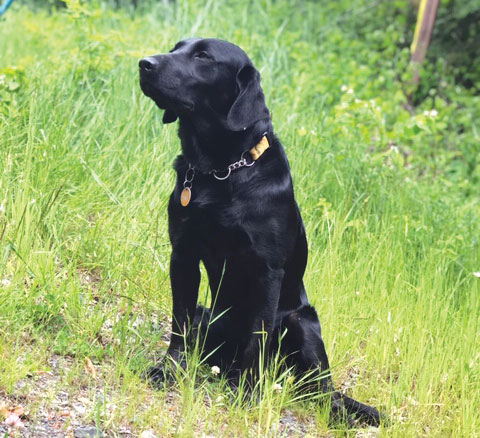
Trained dogs bring comfort and companionship to those in hospitals, nursing homes, forensic units, and juvenile detention centers.
The first time Arlene Padnivelan met the teen at the Calgary Young Offenders Centre, the girl was guarded. She stood outside her door alone, observing the other residents romping with the therapy dogs. Arlene invited her to meet her canine counterpart, Sooty, and the girl agreed. As the teen began petting Sooty, the two chatted about the friendly but introverted black Lab.
“What’s she like when she’s excited?” the resident asked the volunteer.
“She’s pretty mellow until we take out the bike helmet and bike shorts—and then she’s crazy,” said Arlene. “She loves it when we go for a rip.” The girl laughed.
After that meeting, the resident joined her peers on pet nights, hanging out in the common room where they joked about the “comedy troupe” of dogs cavorting, performing tricks, and crawling into their laps.
Arlene wasn’t surprised by the teen’s turnaround. Animals can be great icebreakers, facilitating light-hearted topics of conversation. And these can foster engagement with the humans in the room, lessening the loneliness of their confinement.
Arlene and Sooty are part of Calgary, Alberta’s non-profit organization Pet Access League Society (PALS), dedicated to bringing pets to people who can’t get to their animals or don’t have any of their own. PALS volunteers visit hospitals, nursing homes, forensic units, and a juvenile detention center. Pets provide an important connection, says the organization’s Executive Director, Diana Segboer. They seem to know when we’re struggling and how to help. “Pets have an amazing…ability…to provide us with comfort,” she says.
The canines’ ability to draw people out of their shells is especially handy at the juvenile detention center, where trust is a rare commodity. “The dog’s never done anything, it’s totally non-judgemental,” says Diana. Some kids who are uncomfortable expressing themselves may confide their problems to the pets. This “dry run” can lead to closer relationships with the humans in their lives. Pet night has become such a huge draw card, staff at the detention centre even use it as an incentive for the residents to make positive changes. “What I’ve seen with most kids, (when we’re) bringing the dogs in there, mental health just skyrockets,” says Diana.
Arlene has seen many such shifts generated by the soothing presence of the dogs. “It’s a total peaceful vibe…I haven’t seen an angry kid there,” she says. The animals also provide a welcome distraction from the teens’ troubles. “You give these humans a puppy, whatever beefs they have, they forget,” says Arlene.
Arlene is stoked to play a role in these transformations. “Give these kids a dog and they’re what they’re meant to be…young humans that are gentle (and) loving,” says the handler. “That’s what I love to see.”
Make sure you visit and follow them on Facebook!
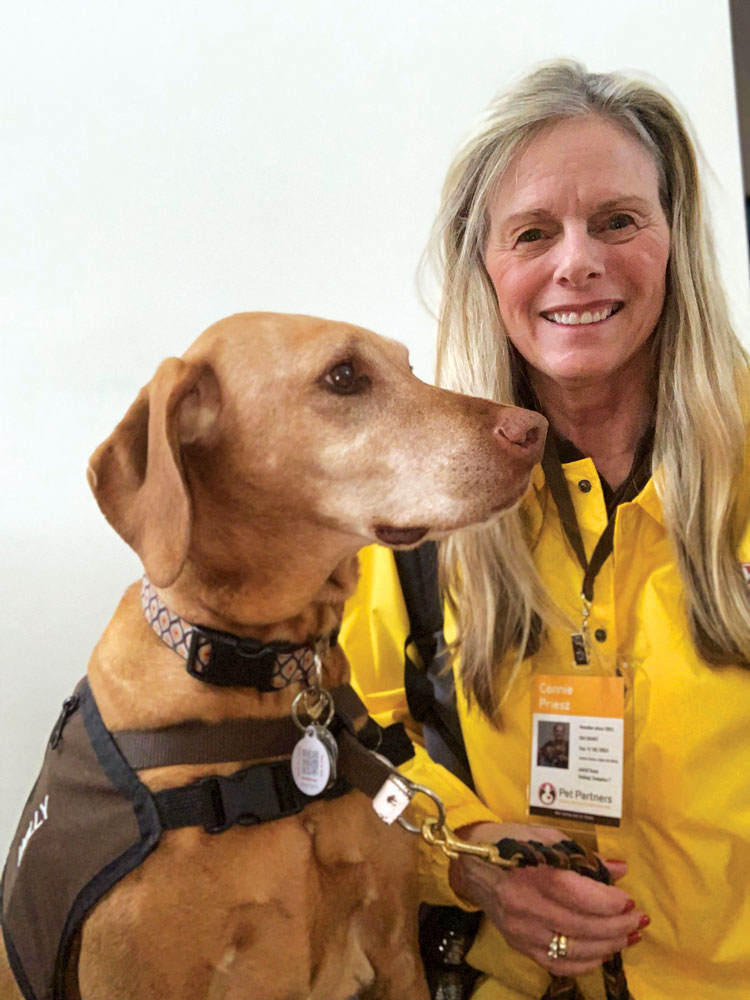
Handlers and their dogs comfort communities in the aftermath of tragedies
Connie Priesz was particularly proud of her dog the day she comforted a young man heading to a friend’s funeral. The deceased, a victim of a car crash, had been a classmate of the teenager. Connie noticed the distraught high school student sitting alone in a corner of the bereaved family’s living room. He kept stealing furtive glances at the friendly rusty-gold Vizsla but didn’t approach the therapy team. Connie asked if he wanted company and he nodded assent.
The mourner started petting the dog, who wagged her tail and looked into his eyes. Molly was signalling that she was there for him, says Connie.
After a few minutes he broke into a wan smile. “She’s beautiful—thank you for being here,” he said.
As he walked away, Connie noticed that his breathing had slowed and his step was lighter. The handler attributed the client’s calming to his connection with the empathic four-footed therapist. “I could see how much the dog…assisted with this emotional crisis,” she says.
Connie and Molly know what they’re doing. The experienced duo belongs to Pet Partners’ Animal Assisted Crisis Response (AACR) initiative, which sends handlers and animals to comfort communities in the aftermath of tornadoes, wildfires, mass shootings, and other tragedies. The program launched in October of last year, says Mary Margaret Callahan, who oversees the organization’s animal therapy projects. Though most of the participants are canines, rabbits, miniature horses, and other mammals also provide stress relief and snuggles.
Volunteers are selected from Pet Partners’ existing therapy teams, who are trained in mental health first aid. The course prioritizes the animals’ welfare, pointing out signs of canine stress such as licking lips or yawning. “All animals need to be willing to do the work…we don’t think about them as tools,” says Mary.
The training also teaches handlers how to comfort victims through active listening. As well, volunteers learn what not to say, including chatting about their own lives or minimizing clients’ feelings.
You give these humans a puppy, whatever beefs they have, they forget.
Sometimes clients avoid conversations, preferring to just pet the dogs or watch them from a distance. “(This) can help ground a person…so they’re not spiralling around in their own thoughts,” says Mary. Once their animals have established the clients’ trust, the handlers can direct the grievers to appropriate resources, such as psychotherapists or physicians.
Connie, who lives close to Minneapolis, Minnesota, has witnessed the soothing effects of the human-animal bond during her work with AACR clients, including 911 dispatchers and classmates of a suicide victim. Dogs can alter our very physiology, triggering the release of the bonding hormone oxytocin, which promotes relaxation.
The dogs’ uncanny intuition is another component of these mini “miracles.” Molly seems to know instinctively what is needed: jumping into a wheelchair, lying in a lap, or performing tricks for a child. In every situation, she provides safety and a momentary sanctuary from suffering. “You forget what has made you feel so bad,” says Connie. “My dog is amazing.”
Visit their website to learn more!

This non-profit turns shelter dogs into service dogs, transforming the lives of veterans living with crippling PTSD
Veteran Amanda Peterson had goosebumps the moment she met her service dog, Chesdin, at the Ponte Vedra, Florida training facility. As the outgoing Basenji/Lab mix approached her, wagging his tail and licking her face, Amanda felt like she was meeting a long-lost friend. In the dog’s comforting presence, an unfamiliar feeling of peace washed over the military veteran, who struggles with post-traumatic stress disorder. “I felt like I was home,” she says.
Amanda and her four-footed therapist belong to K9s for Warriors, a non-profit which supplies service dogs for American veterans with post-traumatic stress disorder (PTSD) and other combat-related conditions. The organization was founded in 2011 by Brett Simon and his mother, Shari Duval. Brett had recently served in Iraq as a bomb dog trainer and returned home with crippling PTSD. He withdrew from friends and family, locked himself in his house with the blinds closed and the television on most of the time, and began drinking. Duval noticed that her son seemed most like himself in the company of canines, and she thought founding the non-profit with Brett could help heal both her son and other struggling veterans.
Amanda has battled the same enemy. Before acquiring Chesdin, she was easily upset and angry. Worse, she was constantly on guard for threats—she couldn’t shop anywhere unless she knew the complete layout of the store, including the location of every exit. Her hypervigilance was so extreme that she became a virtual recluse, holing up at home with her children. “I knew (this) was not a good thing for our bond,” she says. Amanda was at her wits’ end by the time she applied to K9s for Warriors.
It was to be a transformative decision. A recent study by Purdue University’s College of Veterinary Medicine showed K9s for Warriors participants to have lower levels of depression, less social isolation, and higher overall life satisfaction compared to veterans without the service dogs. Participants’ cortisol levels also returned to normal, signalling reduced stress. Suicide rates too have plummeted, says Brett.
The closeness between the pairs, who spend almost every waking moment together, partially explains these results, he says. Caring for their animals helps sidelined servicemen feel valued again. “Responsibility…takes the focus off themselves…onto the dogs,” he continues.
The dogs’ outgoing temperaments and intensive training also contribute to the program’s success. The dogs, all rescues taken from shelters, are screened for inquisitiveness and readiness to engage with humans. Over the next four to six months, dogs are trained to spot and abort PTSD symptoms, including nightmares and panic attacks.
Amanda’s service dog Chesdin knows exactly what to do when his owner is in a funk. He’s “just in tune with me,” says Amanda. One time the dog interrupted a massive panic attack by pawing at her hands and legs until the veteran felt grounded. Chesdin also interrupts her out of flashbacks and wakes her up from nightmares. “He’s combo best friend and psychiatrist,” she says.
He’s also helped Amanda lower her guard in public. When the veteran says “Look,” the animal stands in front of her and leans on her leg to tell her someone is approaching from behind. Knowing this warning system is in place has reduced the magnitude of Amanda’s startle reaction (a symptom of PTSD), and encouraged her to venture out to museums, aquariums, and other children’s activities.
Best of all, her service dog has helped Amanda shift her focus away from her triggering past and back to the present moment. “Instead of remembering things, I’m making memories with my kids,” she says. “That’s one of the biggest blessings.”
Visit their website to learn more!
Join the newsletter and never miss out on dog content again!
"*" indicates required fields
By clicking the arrow, you agree to our web Terms of Use and Privacy & Cookie Policy. Easy unsubscribe links are provided in every email.